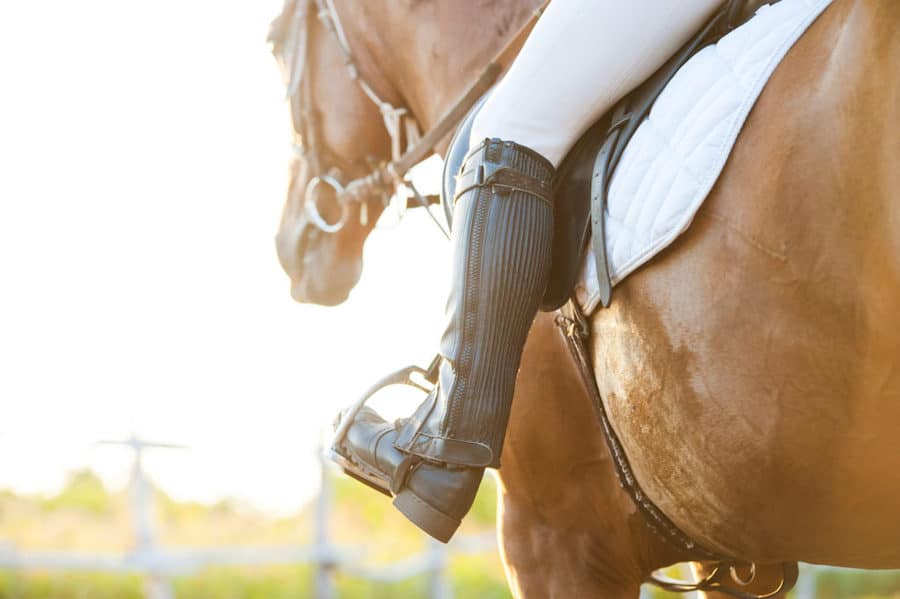Finding the right horse arena footing materials for your arena can be a difficult and confusing process. There are a wide variety of options and price points, and these change depending on whether you are footing an indoor or outdoor arena. Let’s discuss the typical composition of footing, explain how to choose the right horse arena footing materials for your arena, and explore your footing options.
What Is the Composition of Footing?
As you look at options for your arena’s footing, keep in mind that there are three primary areas to address: the base, the subsurface, and the top layer. Each of these have different roles and vary in importance for your equine partners’ health.
- The Base: The base is arguably the most important layer of the arena, as it serves as the foundation that the rest is built upon. Most bases are made out of clay and vary in size depending on the conditions around the arena. Just as the foundation of a building is important to keep it standing for a long time, the base allows the footing in your arena to properly support your horses for a long time.
- The Subsurface: This section is usually made of sand or another similar, manufactured material. The subsurface is between the base and the top dressing, and oftentimes is simply an extension of the top dressing.
- The Top Dressing: This section should contain mostly sand, or some manufactured material, along with a small percentage of clay and silt.
How to Choose the Right Footing for Your Riding Arena
For any horse arena footing, you want to maintain a good balance between the cost and the safety and comfort of your horse. Whether you are constructing or redoing a dressage arena or an arena for jumping, running or other intense actions, ensuring that the arena surface offers significant traction and stability should be your top priority.
There are several factors that affect which footing option is best for you.
- Moisture: One of the most important considerations to make when developing your arena is moisture. If your footing cannot retain moisture, then it will not provide any sort of traction to the horses that move across it. However, if your footing holds too much moisture or you do not have an effective drainage system in place, your footing can become slippery and muddy. Consistent watering combined with a functional drainage system allows owners to maintain an ideal footing.
- Dust: Directly dependent on the levels of moisture, dust is an important consideration when choosing your arena footing. Too much moisture, and dust won’t be a problem. However, if your arena does not have enough moisture the ground will be dry and loose and the horses will kick up dust by walking, running, or jumping on it. The dust they kick up can impact not only the horse’s ability to see, but also their health as well as your own.
- Cushioning: Another important consideration is how much cushioning you provide the horses. Most of the cushioning stems from the subsurface and top dressing. The amount of cushioning that your arena will need varies depending on which riding disciplines are performed at your arena. Having proper cushioning is primarily to keep your horses comfortable and prevent surface injuries.
- Stability: Having stable ground under your horse’s feet is what will allow them to make quick turns and movements, as their hooves will often go directly through the top layers. Without a sturdy base, your horse could easily be injured, and certainly would not be able to make quick movements and starts. Just as having cushioning without a sturdy base can cause injury and inhibit your horse’s performance, stability without cushioning can also hurt your horse and limit their capabilities.
- Traction: Traction is an important part of your arena’s footing. Without it, your horses can easily slip and fall. On the other hand, too much traction, as with an overly moist, muddy footing, can inhibit your horse’s movement and prevent them from performing at their best.
After learning about riding arena footing material selection and management, you can consider the different factors and choose the footing for your arena. It is important that you keep your horse’s health in mind. As Horse Journals remarked, “While horses are able to adapt to a range of surfaces there are limits, and training or competing on dramatically different surfaces may have negative consequences associated with injury, especially at high performance levels.”
What Does Performance Footing Offer?
At Performance Footing, we offer ground stabilization and arena footing solutions that can improve the safety and comfort for you and your horse. Our tested, proven products include FoamFooting, which offers cushioning, reduction in dust and requires less frequent watering. If you are interested in our footing services, contact us today.
